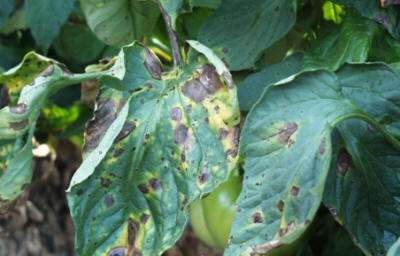|
 Column Column
Tomato Diseases
By John Fulton
 Send a link to a friend
Send a link to a friend
[July 03, 2015]
Tomatoes seem to be a favorite with
gardeners, as they produce an abundance of fruit. Some people grow
large amounts, while others plant one or two in containers. At any
rate, the calls and samples have been trickling into the office for
a few weeks already. Most of the samples have spots, brown leaves,
and dropping leaves, or all of the above. Several diseases hit
tomatoes, but two of the more common ones are early blight and
seporia leaf spot. Blossom end rot seems to have been common on
early tomatoes as well, especially with the extremely wet weather.
|
|
 Early blight, also know as Alternaria leaf spot, can affect
plants at any stage of development. All above ground parts are
susceptible. The most characteristic symptom of early blight are
spreading spots, ľ to Ĺ inch in diameter that form on lower or
older leaves. These spots have dark edges and they are usually
brown to black in the center. These spots frequently merge
forming irregular blotches. Concentric rings often form creating
a 'target' or 'bulls-eye' effect. Affected leaves develop yellow
areas around the lesions. Spotted leaves soon turn yellow,
whither and drop off. The fungus may cause lesions on the fruit
around the stem end and shoulder. The lesion is usually dark
brown to black, up to an inch in diameter, and with distinct
concentric rings. Early blight, also know as Alternaria leaf spot, can affect
plants at any stage of development. All above ground parts are
susceptible. The most characteristic symptom of early blight are
spreading spots, ľ to Ĺ inch in diameter that form on lower or
older leaves. These spots have dark edges and they are usually
brown to black in the center. These spots frequently merge
forming irregular blotches. Concentric rings often form creating
a 'target' or 'bulls-eye' effect. Affected leaves develop yellow
areas around the lesions. Spotted leaves soon turn yellow,
whither and drop off. The fungus may cause lesions on the fruit
around the stem end and shoulder. The lesion is usually dark
brown to black, up to an inch in diameter, and with distinct
concentric rings.

Septoria leaf spot can also affect plants at any stage of
development. Numerous small, water-soaked spots first appear on
the lower leaves. These spots soon become circular to angular
with dark margins and grayish centers often bearing one or more
tiny black bodies called pycnidia which are spore-bearing
structures. Individual lesions are seldom more than ⅛ inch in
diameter and are usually quite numerous on an infected leaf.
Heavily diseased leaves turn yellow, wither and drop off in
large numbers, starting at the base of the plant. Defoliation
can be severe during prolonged periods of warm, wet weather.
As for what to do, here is the checklist: First, keep ripe
fruits picked off the plants. Second, donít work around tomatoes
when they are wet. Next, you can try and improve air
circulation, but if your tomatoes are severely affected you
wonít want to lose any more leaves. And the final step for this
year is to try a fungicide. Mancozeb is probably the recommended
one, but it is very hard to find. The other options are Daconil
and maneb, which are easier to find but probably wonít give you
as good of control. The final step for future years is to
practice at least a three year rotation, with good sanitation in
the garden.
[to top of second column] |

Blossom end rot is a non-pathogenic disease that is very
common during extended dry periods. It also seems to be worse on
tomatoes grown in containers. It begins as light tan
water-soaked lesion on the blossom end of the fruit. The lesions
enlarge and turn black and leathery. This can drastically lower
the yield and lower marketability of the fruits. Fluctuating
soil moisture supply during the dry periods, and low calcium
levels in the fruit are the major causal factors. Control of
blossom end rot consists of providing adequate moisture from
fruit formation to maturity, and use of mulch (grass clippings,
plastic, straw, shredded newspapers, or plastic) to conserve
moisture and even out the moisture supply. Avoid frequent
shallow watering. Water deep and then wait five or more days
before watering again.
[By JOHN FULTON, COUNTY EXTENSION
DIRECTOR SERVING LOGAN, MENARD, AND SANGAMON COUNTIES]

 |